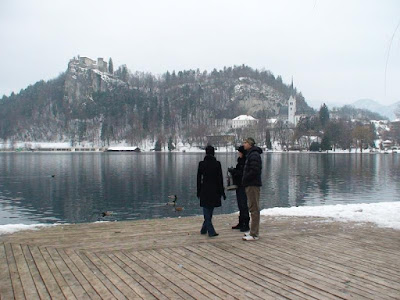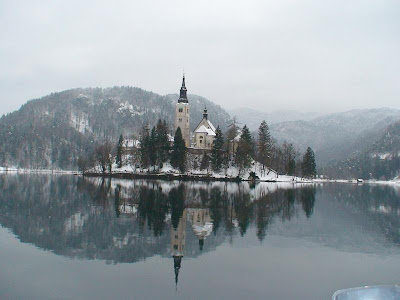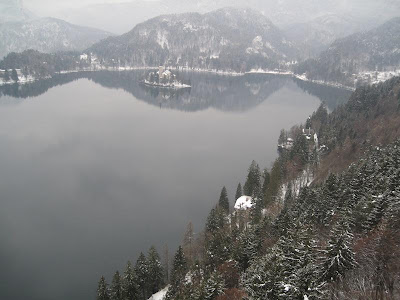Now maybe all you speed headline readers will expect more from this article than I intended, if you didn't read it closely, for I can assure you that there is definitely an 'l' in this 'bed'! Or maybe you just think that I am now typing with a lisp! So let me tell you, I speak of Lake Bled, Slovenia's touristic jewel, which, I am sure, you have all seen at some time in articles or advertisements, the storied isle in the lake, with a high-spired church, clothed by mountains, and crowned by a castle, a veritable photographic feast!. In spring and summer, it is alive with audiences, but under winter's mantle, snow-draped and romantic, in a Dr Zhivago-esque sort of way, it is merely for the hardy of heart and the well rugged – and I am not talking toupee here people – for Bled is bloody cold. But like that other cold beauty, Greta Garbo, it is just as stunning and statuesque.
We came to Lake Bled at the suggestion of my son and his wife, and after long and snowy miles from Vienna. All of Austria was garbed in snow, each mile looking like a Christmas card picture, for snow has the ability to soften even construction sites and industry. Here and there, a smokestack belched milk-white smoke into the air, giving me a fleeting but soon dashed hope, that it might have been from a forgotten steam train, stationary in a long lost siding. We banked around a mist-covered Klagenfurt, like a WWII Bomber Command aircraft, and as I crossed railway tracks which made it a railway junction integral to the Axis war efforts, I envisaged the groans of aircrew when in the briefing room, the "detested Klagenfurt" was revealed. It was in the war years, a well defended target, almost at the extreme edge of bombing runs from England, with lots of enemy fighter planes in between. Yet now, under its blanket of snow, it looked quiet and, well, ordinary! We did not venture into its old city, and glimpsed only briefly its nearby fabled lakes, which Austrians with a fair lack of perspective, label as a "sea". But today, busy Klagenfurt is still an important transport junction, and the nearby lakes are fringed by the mansions, and aptly grand trappings, of the hoi-est of the polloi-est of summer visitors, Austrians as well as others, for it is an area of great beauty.
A mottled, whitish sky, like the stipple on a trout, gave way to a weak blue one as we rose up from Klagenfurt to navigate the serpent-like Loblpass, which is like a knife cut between Austria and Slovenia. Everywhere there were dollops of snow on little chapels and shrines, a million pines, dark, daunting houses, and an inn which in the dusk, looked as though lighted from candles, and I am sure that men in anoraks huddled round the bar with a warming schnapps in their hands. Everywhere, there were pine trees burdened with huge marshmallow-like packed snow, all looking like over-cargoed donkeys, dabs of white on dark green as though painted by a celestial Impressionist. We surged to the top of the pass with a conga-line of lights behind us (well we were in a little Skoda!) and there was a large and menacing concrete border post, as malevolent as Checkpoint Charlie, now brooding and abandoned, such are the porous inner borders of Europe. We were to see many more of these dinosaurs during our travels, reminders of a time more sinister, when one approached them with some trepidation, and a relieving sigh when waved through by a border guard whose outfit always appeared to me as though designed by the same people who gave us the SS uniforms! We were now in Slovenia, once the softest of Marshal Tito’s pro-Communist Yugoslavia, and from there it was all downhill. We passed a number of bloc-built settlements where only a few lights glowed, showing that people came largely in summer, and found our way to Radovljica, a mere rifle shot from Lake Bled.
Radovljica is an otherwise unremarkable town, but it does have a medieval ‘main street’ with a well in the centre, and, to this casual observer, a remarkably high proportion of attractive young blondes! In the main, the people we saw, were clear eyed and angular, the men big of bone and stature, but always helpful and willing to try their English, as our Slovene was non-existent! We stayed at the Lecter Inn, and while in its deep recesses and cellars it could well have hidden a Hannibal, we saw him not. The building is over 500 years old, and has served as an Inn since 1822. Our room, up a flight of creaking stairs, was full of big timber beams in a fourteen-foot ceiling, a nook which once held a roaring fire, and had rough-daubed plaster walls. Everywhere there were little oddments of long gone ages, old musical instruments, a Pfaff sewing machine, a phonograph with wind-up handle and a black bakelite phone, with a similar handle to call the switchboard. Once, the clergy had lived in the Inn, as it was but a shouted “Hail Mary” from the old church, and I though of all those ‘naughty Vicar’ stories when we were led to the Noga Vicar Room, by a lass in period peasant dress! After the clergy, came the bakers, in 1766, and the Inn still has its connections with the ginger-bread trade. Everywhere, on the walls, stairs and counters, there were intricately designed ginger-bread shapes, and little ginger-bread hearts were left on the pillows at night. And this just when I had my heart set on a chocolate!
We ate that night at the Inn, in a restaurant that seemed to have changed little in centuries, with its beams, small windows and big fire place. The fare was solid and peasant-ish, with such delicacies as ‘filled cow’s stomach’, ‘boiled and braised liver’ and ‘pickled tongue’, although my wife refused to eat anything that had previously served as another’s working part! I ordered peasant sausage with potatoes and sauerkraut, and got a king-size serving, all washed down with a delightful Slovenian red and, like my fellow diners, enjoyed the meal immensely. The next morning, my son and I crunched through the snow, and discussed the ways of the world, the heavy grey sky and the white fields merging at a near horizon, me puffing like an old train climbing through a high pass with little poms of steam in the minus something atmosphere. Huge icicles, like walrus' tusks, hung from the rooflines and snow covered everything with an icing sugar-like sheen. Then it was into one of those typically ‘expansive continental’ breakfasts – not that juice, croissant, and coffee excuse that expensive hotels label as ‘continental’, and for which you are charged a fortune! No, here were meats and cheeses, pickles and yogurts, mounds of butter and bread, eggs, aromatic coffee, and veritable tubs of honey and sour cherry jam. In Europe, landlords feel you should be ‘well fuelled’ before you are sent on your way!

Looking to Bled Castle above Lake Bled
Now in the 'old days' the beauty of Lake Bled was confined largely to 'Tito and his Team', the Party apparatchiks who ran Yugoslavia, and they built, or took, villas and dachas, to enjoy the scenic splendour of the lake, or dinners at the castle. We slithered into a snow-decked car park, in which authorities had already piled up yesterday's snows into little hillocks which would have challenged a Sherpa, and made our way to the lake shore. Swans swam serenely on the icy waters, while people all looking much like the Michelin man, wandered within reach of the shoreline hotels and casino. We found a boatman who took us to the island in Lake Bled, which is imaginatively called "Bled Island" and our little electric boat guided us to a frozen landfall, and we eventually made it to the top, surprisingly without the aid of crampons. From a distance, and later from above, it looked just like one of those U.S. Civil War monitors, but was nowhere near as lethal. Atop Bled Island there is a church which looks better at a distance than close up, and a café which served hot chocolate, with the cream of a dozen dairy cows on top. For a fee, you can toll the church bell, but when it tolled the hour it was more a ping of a peal than a good bong, a sort of bell falsetto, and we desisted.
From the island, we looked over to the town – unsurprisingly called Lake Bled, and up at the castle called – you guessed it – Bled Castle, and marvelled at the quietude and exquisiteness of the view. Along the shores there were a plethora of quaint wooden boat-houses, and a four and a half kilometre walking track around the lake for summer night strolling, even a grandstand for watching rowing regattas. Now, with the ice and snow in abundance, however, we merely stamped our feet to revive circulation, and ward off frostbite, and motored back.

Lake Bled island in Lake Bled, across the water from the town of Lake Bled!
Later, with the snow falling, my wife and I drove up most of the 604 metres to Bled Castle, and like eagles flying high, looked down on a sight of great munificence. The island looked like a white petal in a pond, the town below tranquil, steam rising from a grand hotel built over a thermal spring which feeds into Lake Bled, and gives the waters curative powers. When the snowing stopped, we saw the shadowy outlines of the Julian Alps towering well above the castle, looking like a posse of elders standing around the Lake Bled camp-fire. During WWII the castle had served as the regional German military headquarters, and no doubt, it had been a prime posting for the 'boys in grey' – skiing in winter, swimming and boating in summer, with 'spot the partisan' all year round! The castle houses an impressive museum, an austere but million-dollar-view restaurant, with more "z's" in its menu than you hear at a bees' convention! The restaurant serves fine local fare, like Boar's bollocks and Deer derriere, Elk and Marmot, and the castle has a superb wine cellar presided over by a brown-cassocked Abbot, who told us that he had the best selection of Slovenian wines in the whole country! In the evening we had a stunning seven course degustation meal at the nineteenth century, Vila Preseren, with its ultra-modern restaurant, right beside the lake, and concluded that Lake Bled, aside from all its other splendours, was also a gourmand's paradise!

Lake Bled with Bled Island from Bled Castle
The surrounds of Lake Bled offer nature unbridled, with miles of walking trails, paths above rushing streams flowing through gorges, caves, mountain vistas, and an abundance of other lakes, all tree fringed and beautiful. Accommodation is first class to back-packer and the views from many places, are just stunning. Yet now, as we looked down from our eyrie, all slept under its blanket of snow, and in that solace there was a different beauty. It was snowing heavily when we left the next morning, and set our navigational device for Cortina, Italy. Lake Bled, it seemed, was sleeping in again.
Winfred Peppinck is the Tales of the Travelling Editor for Wandering Educators
